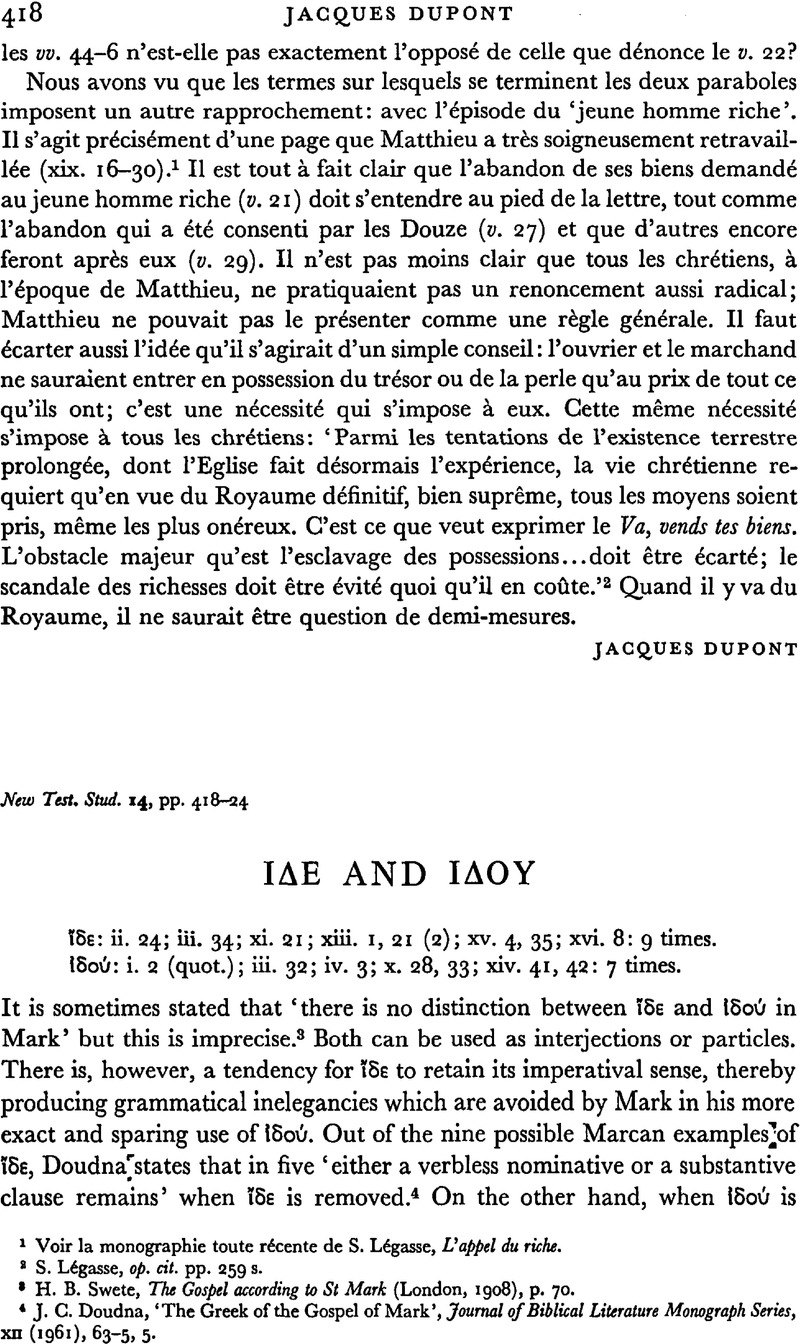No CrossRef data available.
Article contents
Abstract

- Type
- Short Studies
- Information
- Copyright
- Copyright © Cambridge University Press 1968
References
1 Voir la monographic toute récente de S. Legasse, L'appel du riche.
2 S. Légasse, op. cit. pp. 259 s.
3 Swete, H. B., The Gospel according to St Mark (London, 1908), p. 70.Google Scholar
4 Doudna, J. C., ‘The Greek of the Gospel of Mark’, Journal of Biblical Literature Monograph Series, xii (1961), 63–5, 5.Google Scholar
1 Black, M., An Aramaic approach to the Gospels and Acts (Oxford, 1946), pp. 87–8. Some of the imperatival force persists in the Welsh ‘Look you!’Google Scholar
2 Mark iii. 32–4.
3 Swete, op. cit. p. 70.
4 Doudna, op. cit. p. 65.
5 Doudna, p. 63; I Chron. xxi. 23 (האו); Gen. xxvii. 6 (הגה).
1 Matthew uses ׀δού 32 (out of 62 uses) in narrative, Luke 16 out of 57. H. Schürmann, ‘Der Paschamahlbericht, I. Teil ciner Quellen-kritischen Untersuchung des Lukanischen Abendmahlsberichtes’, Neutestamentliche Abhandlungen (Münster, 1953), p. 93 ‘eine Vorzugswendung des Matth. und Luk., wohl in Anlehnung an LXX-sprachgebrauch’.
2 One possible exception is Mark i. 2.
Marcan text is: (καὶ) ׀δού ἀποστέλλω τόν ἂγγελόν μου πρό προσώπου σου(i. 2).
Luke (Q) reads: ׀δού ἀποστέλλω τόν ἄγγελεόν μου πρό προσώπου σου (Luke vii. 27).
Exodus xxiii. 20 a reads, however: καὶ ׀δού ἐσώ ἀποστέλλω τόν ἄγγελόν μου πρό ποσώπου σου (LXX).
A strict citation from the Exodus Septuagintal text should read, καὶ ׀δού but the Hebrew reads, ‘Behold, I myself will send…’. Mark, unlike Matthew and Luke, never uses καὶ ׀δού elsewhere in the gospel; surely a strong argument for Mark's liability to omit καן
3 Allen, W. C., Gospel according to St Matthew (Edinburgh, 1957), p. lxxxvi.Google Scholar
4 Moulton, J. H., A Grammar of New Testament Greek, vol. i, Prolegomena (Edinburgh, 1949), p. II.Google Scholar
5 Ecclesia, p. 179.
1 Almost the same text is found in a ‘Q’ passage in Matthew and Luke. Either they have omitted this conflation here, or it was absent from their Marcan text. These facts have convinced some scholars that Mark i. 2 is a scribal insertion made early in the textual tradition.
2 Swete, , p. 69; Taylor, p. 246; M. Zerwick, Biblical Greek, Scripta Pontificii Instituti Biblici, English ed. J. Smith (Rome, 1963), p. 2. Taylor doubtful, Trocmé strongly against but Zerwick and C. H. Turner in favour.Google Scholar
3 Mark iii. 34.
4 Trocmé, La Formation de l'évangile selon Marc (Paris, 1963), pp. 67–8. Trocmé suggests that the pericope reflects an attitude anti-James and the family of Christ on the part of the early Christian Church.Google Scholar
5 Mark iv. 3.
6 Matt. xiii. 9.
7 Luke viii. 8.
8 Matt. xiii. 9; Luke viii. 8.
1 Mark x. 29–30.
2 x. 33.
3 x. 32.
4 Taylor, p. 438, ׀δού, ἀναβα׀νομεν εὶς ’׀εροσόλυμα; ὁυ׀όςτοῡ ἀνθρώπου; παραδ׀δωμι; ἀρχιερεῑς; γραμματεύς; ἔθνος ‘Many of these words and phrases are common in Mark and on the whole it may be said that the vocabulary reveals the Evangelist's hand.’
1 i. 18, ii. 14, 15, v. 24, vi. 1, viii. 34, ix. 38, x. 21, 28, 32, 52, xi. 9, xiv. 13, 54, xv. 41, xvi. 17.
2 i. 10, iii. 13, iv. 7, 8, 32, vi. 51, x. 32, 33, xv. 8.
3 i. 15.
4 i. 2.
5 iii. 32.
6 iv. 3.
7 x. 28.
8 x. 33.
9 xiv. 41, 42.
10 i. 15.
11 iii. 32, x. 28, 33, xiv. 41, 42.


